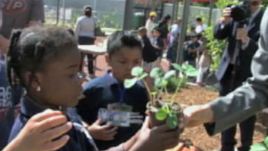
This is the VOA Special English Education Report.
Outdoors, in the open air, seems like a natural place to study natural science. It also makes sense in a place like Southern California where people like to be outside a lot. Now the Natural History Museum of Los Angeles County is working to bring the indoors to the outdoors for its visitors.
The museum has redesigned an outdoor space into a living exhibit. This is a big change for the 1.5 hectare area. It used to include a parking lot. Now, instead of cars, it welcomes birds, butterflies and other living things.
EVA ENG: "What else do the plants need, Jaime?"
CHILDREN: "Sunshine!"
Teacher Eva Eng and her young students recently visited the museum's outdoor campus. Ms. Eng says they enjoyed their experience. The children were learning about plant science in school.
EVA ENG: "They really like hands-on things, getting their hands in the mud, and planting seeds, watering them, watching them grow."
Scientists who work at the museum come outside to describe plants and insects in the natural setting of this outdoor laboratory.
Greg Pauly specializes in studying turtles, like the western pond turtle. He tells the students how development has changed its natural habitat. He says these turtles are happiest around small bodies of water that grow and shrink with the seasons.
GREG PAULY: "You know, 150 years ago, before there were very many people here, all the streams were just seasonal streams. And the western pond turtle loved that habitat. And with people, we have changed the habitat."
Today, he says, there is a lot more permanent water, like a pond at the Natural History Museum itself. And he says the changing habitat is one reason why western pond turtles are shrinking in number.
In addition to science lessons, the open-air exhibit can provide contact with nature in a way that some city children rarely get.
Landscape architect Mia Lehrer says children can get real-life answers to questions they may be wondering about.
MIA LEHRER: "What does it mean to see what strawberry plants look like, that they do not come from a container in the store? And a tomato -- children have been asked, 'Where does ketchup come from?' They do not know."
Only parts of the new outdoor campus are open now. But Karen Wise says more changes are coming. Ms. Wise is the museum's vice president for education and exhibits.
KAREN WISE: "Now we are opening up the whole museum, making it an indoor-outdoor experience, so that our visitors can be a part of the experience."
The work is expected to be completed by June of 2013. Next year is the museum's 100th anniversary.
And that's the VOA Special English Education Report. You can watch a video about the new outdoor exhibit at the Natural History Museum of Los Angeles County at voaspecialenglish.com. You can also read, listen and learn English with our programs and activities. I'm Bob Doughty.
A new exhibit of bright life in New York City
Teens get a history lesson from history makers
Science on view and not at the museum of natural history in Washington
Six building designers who are redefining modern architecture
(来源:VOA 编辑:旭燕)
